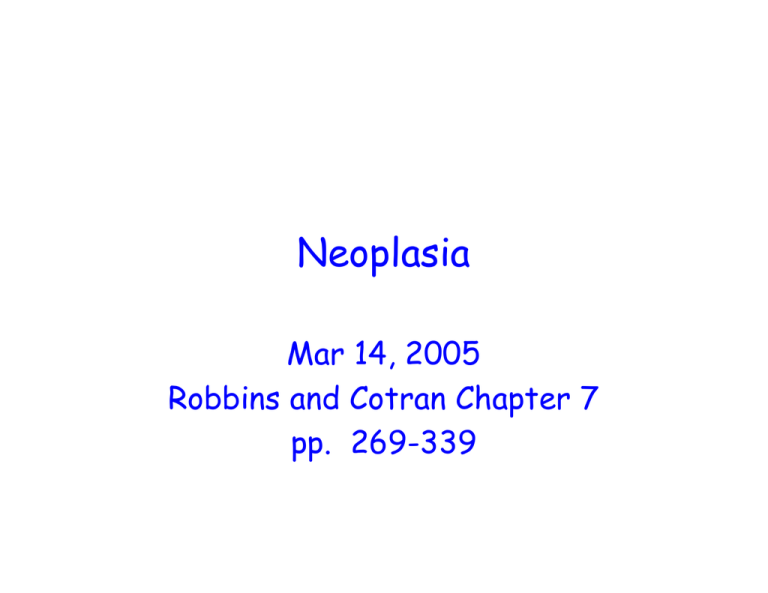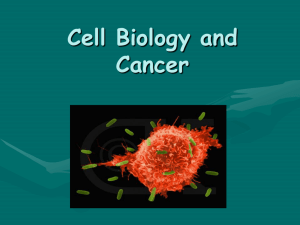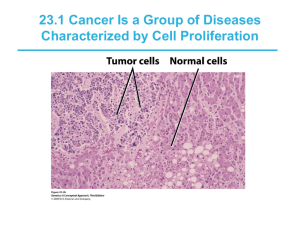Neoplasia Mar 14, 2005 Robbins and Cotran Chapter 7 pp. 269-339
advertisement

Neoplasia Mar 14, 2005 Robbins and Cotran Chapter 7 pp. 269-339 Definitions • Neoplasia - new growth – Abnormal mass of tissue with growth that exceeds and is uncoordinated with that of the surrounding normal tissues; autonomous • Tumor - synonymous with neoplasm • Cancer - common term for malignant neoplasm • Neoplasms have parenchyma and stroma • Benign and malignant tumors each have their own nomenclature Benign tumors • Based on parenchymal component • Mesenchymal tumors add -oma to cell of origin – Fibroblasts = fibroma – Cartilage = chondroma – Osteoblasts = osteoma • Epithelial tumors can be named for cell of origin, microscopic architecture, or macroscopic appearance – Adenoma = glandular appearance OR from glandular tissue Malignant tumors • Mesenchymal tumors usually called sarcomas – Fibrosarcoma, liposarcoma, leiomyosarcoma, rhabdomyosarcoma • Epithelial tumors usually called carcinomas – Adenocarcinoma = glandular growth pattern – Squamous cell carcinoma = squamous pattern – Can either be named for organ of origin, or “poorly differentiated” or “undifferentiated” • Many exceptions Liver tumors • Focal nodular hyperplasia - spontaneous • Nodular regenerative hyperplasia - portal hypertension • Hemangiomas - benign blood vessel tumors • Liver cell adenomas - rarely become malignant • Hepatocellular carcinoma (HCC) - common • Cholangiocarcinoma - much less common Biology of tumor growth 1) Malignant change in target cell (transformation) 2) Growth of the transformed cells 3) Local invasion 4) Distant metastases • Generally, morphologic criteria can be used to distinguish benign and malignant tumors, but not always Differentiation and anaplasia • Differentiation = extent to which neoplastic cells resemble normal cells • Anaplasia = lack of differentiation – Hallmark of transformation – But cancer is not “reverse differentiation” • In general, benign tumors are well differentiated • Malignant tumors range from well differentiated to undifferentiated Features of anaplasia • • • • • Pleomorphism Abnormal cell morphology (atypia) Abundant and/or atypical mitoses Loss of polarity Dysplasia = “disordered growth” – In epithelia, represents a state between hyperplasia and carcinoma in situ (preinvasive neoplasia) – Does not necessarily progress to cancer Rates of tumor cell growth • From 1 transformed cell to smallest clinically detectable mass (1 gm) of 109 cells = 30 doublings • To reach 1012 cells (1 kg) requires only 10 additional doublings – Doubling time of tumor cells – Fraction of tumor cells replicating – Rate at which cells are shed/lost • Total cell cell-cycle time is typically normal Figure removed for copyright reasons. Source: Figure 7-12 in [RC] Kumar, V., A. K. Abbas, and N. Fausto. Robbins and Cotran Pathologic Basis of Disease, 7th ed. Philadelphia PA: Elsevier, 2005. ISBN: 0721601871. Local invasion and metastasis • Growth of cancer is usually accompanied by progressive infiltration, invasion, and destruction of surrounding tissue • Next to metastasis, invasiveness is the most reliable feature that distinguishes malignant tumors from benign tumors • Metastasis (tumor mass discontinuous with the primary tumor) unequivocally marks a tumor as malignant Figure removed for copyright reasons. Source: Figure 7-22 in [RC] Molecular basis of cancer Acquired (environmental) DNA damaging agents: Normal Cell • • • • Nonlethal genetic damage Clonal expansion of a precursor cell Main classes of genes involved 1) Oncogenes 2) Tumor suppressor genes 3) Genes regulating apoptosis 4) DNA repair genes Carcinogenesis is a multistep process 1. Chemicals 2. Radiation 3. Viruses Successful DNA repair DNA Damage Activation of growth-promoting oncogenes Failure of DNA repair Inherited mutation in: Mutations in the genome of somatic cells 1. Genes affecting DNA repair 2. Genes affecting cell growth or apoptosis Inactivation of tumor suppressor genes Unregulated cell proliferation Alterations in genes that regulate apoptosis Decreased apoptosis Clone Expansion Angiogenesis Additional mutations Escape from immunity Tumor progression Malignant neoplasm Figure by MIT OCW. Invasion & metastasis Figure removed for copyright reasons. Source: Figure 7-31 in [RC] Oncogenes • First recognized in acute transforming retroviruses (v-onc) • Most known oncogenes do not have viral counterparts • Function as growth factors, receptors, signal transducers, transcription factors, and cell-cycle components • Have similar functions as protooncogenes, but lack regulation/are constitutive Figure removed for copyright reasons. Source: Figure 7-32 in [RC] RAS oncogene • 15-20% of all human cancers have a RAS mutation • Normally, RAS is activated by receptors to exchange GDP for GTP • Activated RAS returns to ground state by its intrinsic GTPase activity • GTPase activating proteins (GAPs) augment this process • Mutant forms of RAS bind GAP but their GTPase activity is not augmented Tumor suppressor genes • Normally serve to inhibit cell proliferation • First recognized in retinoblastoma, rare pediatric tumor of the eye • RB tumor suppressor gene is a nuclear phosphoprotein that regulates cell cycle – Active, hypophosphorylated state in nondividing cells – Inactive, hyperphosphorylated in G1/S transition • Many cancers have mutations in the RB pathway (i.e. INK4a, Cyclin D, CDK4) OF RETINOBLASTOMA Figure by MIT OCW. Retinoblastoma Retinal Cells Somatic cells of child Zygote Normal gene Germ cells Somatic cells of parents PAT H O G E N E S I S FAMILIAL FORM Mutation Mutant Rb gene Mutation Mutation SPORADIC FORM Metastasis • Invasion of ECM – Detachment from cells – Attachment to ECM – Degradation of ECM – Migration of tumor cells • Vascular dissemination – Adhesion molecules – Chemokines Figure removed for copyright reasons. Source: Figure 7-42 in [RC] Tumor immunity • Immune surveillance – Cancer immunoediting • Tumor-specific antigens • Tumor-associated antigens • Anti-tumor effector mechanisms – – – – CTL NK cell Macrophages Antibodies Normal host cell displaying multiple MHC-associated self antigens Normal self proteins No T cell response MHC Class I Tumor cells expressing different types of tumor antigens Product of oncogene or mutated tumor suppressor gene Mutated self protein Overexpressed or aberrantly expressed self protein T cell T cell CD8+ CTL T cell T cell CD8+ CTL Various mutant proteins in carcinogen, or radiation, induced animal tumors; various Tumor suppressor gene mutated proteins in products: mutated p53 melanomas protein Oncogene products: mutated RAS, Bcr/Abl fusion proteins Examples Oncogenic virus Figure by MIT OCW. Overexpressed: tyrosinase, gp100, MART in melanomas Aberrantly expressed: cancer-testis antigens (MAGE, BAGE) T cell Virus antigen-specific CD8+ CTL Human papilloma virus E6, E7 proteins in cervical carcinoma: EBNA proteins in EBV induced lymphoma Anti-tumor immunity MHC molecule Immune evasion by tumors Failure to produce tumor antigen Tumor antigen Antigen-loss variant of tumor cell Tumor cell T cell Mutations in MHC genes or genes needed for antigen processing T cell Production of immuno-suppressive protein Class I MHC-deficient tumor cell T cell T cell Immunosuppressive cytokines (e.g., TGF-β) T cell specific for tumor antigen T cell recognition of tumor antigen leading to T cell activation Lack of T cell recognition of tumor Lack of T cell recognition of tumor Figure by MIT OCW. Inhibition of T cell activation Special topics • • • • • • Epidemiology p53 Epigenetic changes Chemical carcinogenesis Microbial carcinogenesis Molecular profiling – Genomic – Proteomic







